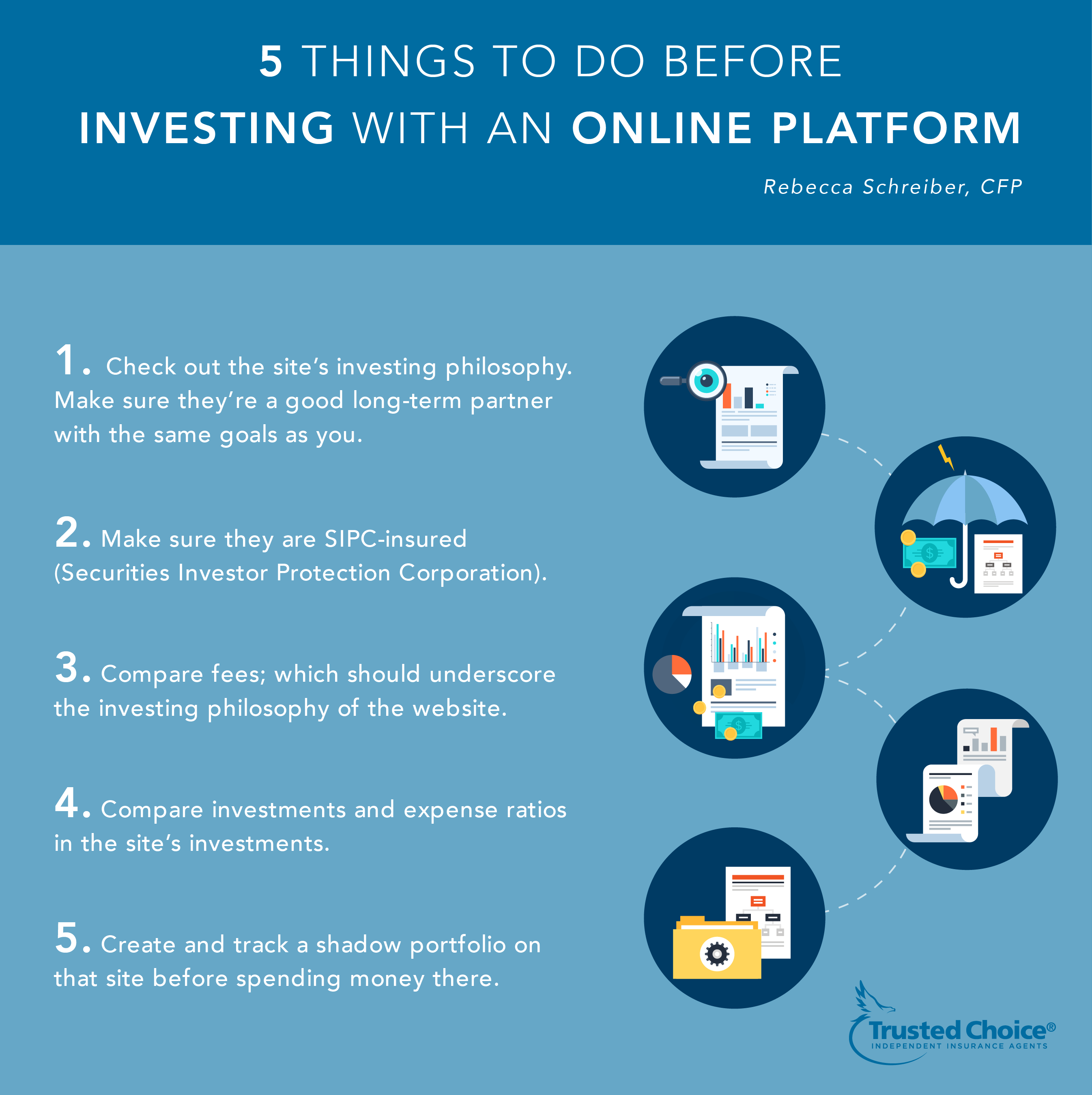Beginning Investors: How to Invest Money Online

If you’re like many people, you want to start using online platforms to invest but you think it’s hard, expensive and downright scary. Because investing can be risky, you’re afraid you’ll lose a lot of money you can’t afford to lose because you’re not sure how to do it right. But it doesn’t have to be like that if you know what you’re doing. We asked two personal finance educators to provide the best strategies for beginners moving into online investing.
One is Dr. Mary Ann Campbell, CFP. A visiting professor at the University of Central Arkansas, where her students call her “Dr. MAC,” she is a frequent television commentator on personal finance and she uses magic to teach personal finance in her classes. The other is Rebecca Schreiber, CFP, principal of Pure Financial Education in Silver Spring, MD, which focuses on helping early and mid-career professionals to make smart financial decisions. Both have been fee-only financial planners in the past, pride themselves on providing unbiased financial education, and are well-versed in investing strategies for beginners. After reading this article, you’ll know what to do and be able to formulate your own strategy to get started.
Trading vs. Investing
The first thing you need to understand is the fundamental difference between two terms often used interchangeably: trading and investing. The two are not the same. Says Schreiber, “Investing is a long-term approach to growing your money over a long period and is considered quite profitable.” This is the strategy she recommends to her clients and seminar students.
“Trading is jumping in and out of stocks when you see an opportunity to make a profit,” she continues. She says trading makes lots of money for the trading platform but not for individuals. “Your interests and those of most trading platforms are not aligned because they want you to trade (to generate revenue) and you want your investments to increase in value over time. So you’re paying people who want something different from you than you do from them.”
“Know the differences between 'trading' and 'investing' and focus on 'investing' for long term returns and to mitigate losses.”
Dr. MAC is averse to trading as a practice and likens it to “day trading,” in which you keep a stock throughout a single day and then sell it before nightfall. She doesn’t recommend the practice and tells those who ask her about it to get a book and get educated. She agrees with Schreiber about investing, saying, “Slow and steady will win the race for most people.
”Because our goal is to help you choose fiscally sound personal finance strategies, our focus is long-term investing. Keep in mind that these are all recommendations, not endorsement, so do your own research.
Before You Start Investing Online
There are three important things you should do before you start investing online. The first is overcoming any fear you have of investing. Schreiber says that fear “Comes from fear of loss. Our fear of loss is more powerful and more motivating than the potential for gain.” That’s especially true when it comes to money. “We are more afraid to lose our money than we are hopeful of gain,” she continues. But the best way to overcome those fears is by completing these next two steps before investing. Make sure you have an emergency fund.
Both experts agree on this. Dr. MAC says, “Have at least $1,000 set aside to cover emergencies.” You can keep building your emergency fund at the same time that you’re investing, but because investment instruments are not usually liquid assets—you can’t get the money immediately if you need it—you should have cash set aside in a savings account.

Schreiber says, “Save with banks and invest with investment companies.” Banks are set up to manage depository accounts, like your emergency savings. “Investing is not their bread and butter; they are an intermediary between investment houses and consumers,” she explains. So their fees are higher than those of investment firms. She cautions that before using banks for investments, “Look at the account fees and the expense ratios the banks are going charge.”
Second, get educated about investing generally and online investing specifically. The more you know, the smarter and more confident you’ll be as an investor—though being overconfident can lead to trouble. Moreover, there is an overwhelming amount of information out there about investing, but Dr. MAC says to make sure you choose highly credible, unbiased sources, especially at first.
She recommends several sources of good information:
- Start with your local library and get books from reputable authors and sources like the “For Dummies” series written by Eric Tyson (who refuses money for anything he writes about). You’ll probably find books there from other recognized sources like Morningstar and Dave Ramsey.
- Read blogs and publications by those who are unbiased, including Liz Weston, Stacey Johnson, Jack Bogle, Jane Bryant Quinn, Kathy Kristof (on Kiplinger and CBS Moneywatch), Money.gov, Planet Money and the Consumer Reports “Money Alert” email newsletter. She also recommends TedTalks and YouTube videos on personal investing. All offer great general personal finance advice, but you’re specifically looking for credible beginning investor education from these sources.
- Someone you know who has done well investing. Ask them how they did it, but before following their advice, make sure it fits your goals and personality.
- The investment platforms themselves. They often have strong educational sections and toll-free support to help you find content on their sites that helps you understand how to use the sites. “Charles Schwab and Fidelity have excellent research centers,” she says.
Schreiber recommends that you make certain that “Guidance is not coming from people who are getting compensated to get you to invest and who will try to scare you into investing without showing you how you can afford to invest.” She suggests several sources of education as well:
- The book “The Motley Fool’s You Have More Than You Think: The Foolish Guide to Investing What You Have,” by David & Tom Gardner. While Schreiber said the Motley Fool blog has become a resource for advanced investors, their book is easy to understand for beginners.
- Two websites she recommends for unbiased, robust information are on the Investor webpage and the National Endowment for Financial Education.
- Your employer. “Many employers offer financial wellness programs,” she says, which include education on investing. In fact, under ERISA (the Employee Retirement Income Security Act of 1974), they must provide a certain level of education about employer-based investing. Most employer programs also strongly encourage savings and investing.
Further, like Dr. MAC, she is a big proponent of talking to other people you trust who you know are savvy with money and have had some success in investing.
There are many more, but these are a good start for learning basic investment strategies. You can use a site like Investopedia.com to look up terminology you don’t understand and the check out then SEC’s director of investor education sites. Avoid sensational sources and those tied to products or personalities, because they may not provide unbiased information.
Choosing the Right Platforms and Strategies
Once you’ve gotten educated, you should identify the best online platforms for your goals and personality, which you will know after you’ve been researching for a while. Because our experts believe your focus should be on long-term investing, you should avoid brokerage platforms that allow you to borrow money to trade, and trade frequently. Again, your goal is to invest for the long run, so a site should make you jump through hoops to get your money, including charging you fees to cash out.
Also, know your risk tolerance before you get started. If you’re someone who feels overwhelmed when the stock market starts to fall, you’ll want to stick with more conservative investments. If you can withstand market volatility without becoming terribly nervous, you may want to consider more aggressive investing. Knowing the site’s investment philosophy will help you determine if it fits your risk tolerance.
But how do you know how to invest and where? Schreiber suggests that instead of investing money immediately, you create a shadow account on a site like Vanguard. “Pick the fund you’d invest in and an investment strategy and follow it with paper and pen, practicing your investment approach for six months,” she explains. While you’re engaged in this strategy, learn investing terminology and research as much as you can about fees and expenses. This is critical, because different platforms have different fee and expense structures.
“Beginners should start slow. Begin by creating a shadow account and move on to drip investing. Also, stick with investments with a strong history and avoid those you don’t clearly understand.”
If you’re ready to invest a small amount of money, Dr. MAC suggests drip investing. That is investing in one or two stocks using a small amount of money. “Some stocks will allow you to invest a minimum, like $250 or $500, but you can start by paying monthly until you reach the minimum investment for that stock. Others have no minimums.”
To learn more about drip investing, she recommends Charles Carlson’s Drip Investor newsletter and website. But, she adds about this strategy, “Do your homework before you go in, select the stock and live with for a while.” If it doesn’t meet your investment goals within six months, you can always sell it and buy something different.
To learn about stocks you’d like to invest in, Dr. MAC suggests using Yahoo! Finance, Google Finance and Charles Schwab’s site. Again, follow them for several months and see how they do over the long term. You’ll also need to look at historical data.
Also, to play it safe, stick with investments you thoroughly understand as well as those that have a strong history. Schreiber says those include TIAA-CREF, government thrift savings plans and target date funds. “If you get into mutual funds, know what’s in them so you’re not investing in something you don’t support,” she says. You’ll also want to stay with sites that are insured by the SIPC (Securities Investor Protection Corporation).
Finally, carefully evaluate new strategies like smartphone investing apps using robo-advising technology. They are based on automated advice without the kind of human assistance offered by many online investment sites. Make sure you’re not getting scammed or will lose money you can’t afford to lose on these. Know their security level, terms and conditions, fees and expenses thoroughly before connecting your bank accounts.
